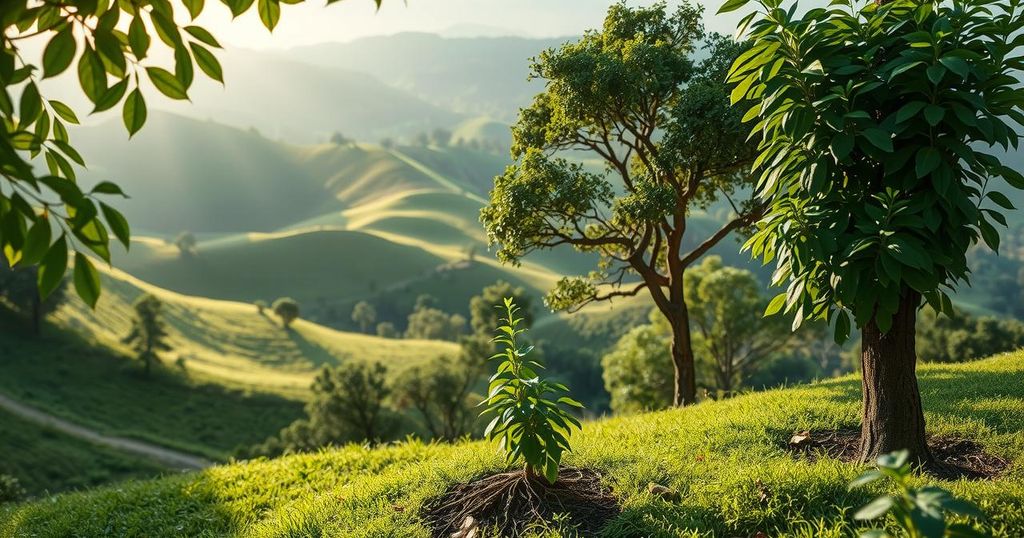Reforesting Malawi’s Mount Mulanje: A Path to Restore Vanishing Woodlands
Mount Mulanje, a vital ecological resource in Malawi, faces severe deforestation and impacts from climate change, most recently Tropical Cyclone Freddy. Conservation initiatives, particularly those focusing on the Mulanje cedar, aim to restore the area while providing sustainable income for local communities. Collaborative efforts are required to combat illegal logging and foster regeneration in both the mountain’s forests and the surrounding miombo woodlands.
Mount Mulanje, known as Malawi’s “Island in the Sky,” is a critical ecological zone containing unique biodiversity, vital water resources, and significant cultural value for local communities. However, the area has undergone severe deforestation in recent decades, particularly impacting the miombo woodlands and higher elevation forests. To combat this issue, the Mulanje Mountain Conservation Trust and collaborators have been focusing on reintroducing the endemic Mulanje cedar and launching reforestation initiatives to provide sustainable income for communities and lessen pressure on the forests.
In March 2023, Tropical Cyclone Freddy struck Malawi, resulting in unprecedented rainfall and significant destruction. This cyclone, the most powerful ever recorded, severely affected the communities surrounding Mount Mulanje, which had already suffered from illegal logging and environmental degradation. The loss of tree cover exacerbated flooding, turning hillsides into torrents that devastated local villages and agricultural lands.
The devastation caused by Cyclone Freddy has prompted a newfound awareness within these communities regarding the importance of forest conservation. According to local environmental educator Kondwani Chamwala, many residents now recognize the need to protect remaining trees. Mount Mulanje, characterized by its impressive peaks and unique flora, is not only a natural treasure but also holds spiritual significance for the locals. However, despite being designated as a forest reserve and a UNESCO Biosphere Reserve, threats to its biodiversity persist.
Over a million people reside in districts adjacent to Mount Mulanje, relying on agriculture for their livelihoods. The southeastern region is predominantly occupied by tea plantations, while the surrounding lands that once boasted rich biodiversity and resources have been depleted. As a child, Chamwala fondly remembers gathering fruits in the miombo woodlands; however, these resources have diminished, forcing women to traverse greater distances to collect firewood and leaving many rivers nearly dry.
Malawi faces significant economic challenges, with 70% of its population living below the poverty line. Climate change, alongside economic pressures, has led locals to exploit forest resources further. Recent satellite data reveals a staggering loss of forest cover, with the Mulanje Mountain Forest Reserve losing nearly 600 hectares from 2002 to 2023, and much of this loss correlating with the extreme weather events caused by climate change.
One of the most critically endangered species on Mulanje is the Mulanje cedar (Widdringtonia whytei), which occupies a narrow elevation range. Over the years, illegal logging and various environmental challenges have led to a dramatic decline in its population. A 2017 survey identified only seven live trees remaining, highlighting the urgent conservation efforts needed to revive this national treasure.
Conservation initiatives began in 2004, with the Mulanje Mountain Conservation Trust spearheading efforts to cultivate and plant cedar seedlings. Although initial attempts were hindered by fires and mortality rates, recent strategies have improved. The approach now emphasizes community involvement in nursery cultivation, fire management, and seedling growth, ultimately yielding better survival rates as communities benefit from nurturing their environment.
Community efforts to restore the Mulanje cedar also face challenges from ongoing threats such as fire and illegal logging, exacerbated by insufficient enforcement of conservation laws. Notably, the cedar was designated under CITES Appendix II in 2019 to curb international trade, and while regulations exist, the practical realities of enforcement remain problematic. The local forestry department’s limited funding further complicates effective management and protection of this fragile ecosystem.
Conserving the biodiversity around Mount Mulanje also necessitates a focus on the neighboring miombo woodlands. Historically rich in resources for local populations, these woodlands have suffered from overharvesting, yet they exhibit natural regenerative properties if adequately protected. Collaborative efforts with local communities aim to regenerate these areas, while organizations like WeForest provide essential support for conservation practices and sustainable income generation options.
The Mulanje Mountain Conservation Trust continues to pursue innovative avenues for fostering community engagement, such as developing value-added products from miombo resources. Products like dried fruits and essential oils derived from local plants aim to provide economic alternatives to unsustainable resource extraction. While progress has been made, consistent support and collaboration are crucial for the ongoing protection and revitalization of Mulanje’s biodiversity, as emphasized by Carl Bruessow, MMCT Executive Director.
The plight of Mount Mulanje underscores the intricate balance between local livelihoods and environmental conservation. As stakeholders work tirelessly to restore the Mulanje cedar and the surrounding ecosystems, community awareness and involvement will be pivotal in shaping sustainable futures. Effective partnerships, ongoing funding, and innovative conservation strategies are necessary to protect this vital ecological heritage for generations to come.
Original Source: news.mongabay.com




Post Comment